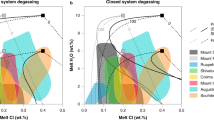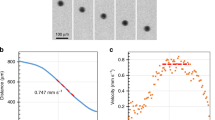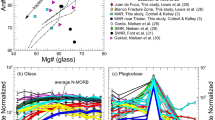Abstract
Arising from: A. E. Saal, E. H. Hauri, C. H. Langmuir & M. R. Perfit Nature 419, 451–455 (2002); Saal et al. reply Assessing the conditions under which magmas become fluid-saturated has important bearings on the geochemical modelling of magmas because volatile exsolution may profoundly alter the behaviour of certain trace elements that are strongly partitioned in the coexisting fluid1. Saal et al.2 report primitive melt inclusions from dredged oceanic basalts of the Siqueiros transform fault, from which they derive volatile abundances of the depleted mantle, based on the demonstration that magmas are not fluid-saturated at their eruption depth and so preserve the mantle signature in terms of their volatile contents. However, in their analysis, Saal et al.2 consider only fluid–melt equilibria, and do not take into account the homogeneous equilibria between fluid species, which, as we show here, may lead to a significant underestimation of the pressure depth of fluid saturation.
Similar content being viewed by others
Main
For any basalt melt that is at fixed temperature and pressure in fluid-saturated conditions with known H2O and CO2 concentrations, the corresponding volatile fugacities, fH2O and fCO2, can be calculated3. The phase rule states that this in turn fixes the fugacities of all other C–O–H fluid species, including fO2 (ref. 4). Figure 1a shows the covariation of the mole fraction of H2O and CO2 (XH2O and XCO2) in a C–O–H fluid calculated for various fO2 at 1,200 °C and 400 bar (fO2 expressed in log units relative to the solid buffer Ni–NiO, referred to here as NNO). It can be seen that at a very low mole fraction of H2O (XH2O < 0.05), reduced fluids are poorer in CO2 than oxidized ones: for instance, at ΔNNO = −2 the mole fraction of CO2 is 0.8, whereas at ΔNNO = −0.8, it is 0.95. This is due to the progressive reduction of CO2 into CO, which becomes significant at fO2 below ΔNNO = −1 (ref. 4).
a, Covariation of XH2O and XCO2 (where Xi is the mole fraction of species i) in a C–O–H fluid calculated for various values of fO2 (numbers along each curve). The calculations were done by fixing fH2 (either 0.01 bar or 1 bar, corresponding to red and green symbols, respectively) and fH2O, which allows us to calculate fCO2 in the C–O–H system4. Once fH2 and fH2O are fixed, fO2 can be calculated through the equilibrium H2 + 0.5 O2 = H2O. T, 1,200 °C; P, 400 bar. b, H2O–CO2 solubility diagram for a basalt at 1,200 °C and 400 bar and equilibrated with fluid compositions shown in a. For any given fH2O and fCO2 set of values, the corresponding H2O and CO2 contents of the melt are computed according to ref. 3. The fO2 is shown along each line in log units calculated relative to the solid buffer Ni–NiO. The Siqueiros bar shows the range of H2O content of Siqueiros melt determined by Saal et al.2. c, Evolution of the pressure of fluid saturation with fO2 of a basalt melt having 40, 132 and 240 p.p.m. CO2 and 0.1 wt% H2O, which are minimum, average and maximum CO2 contents, respectively, of the Siqueiros melt inclusions2. At an fO2 below ΔNNO = −1, the pressure of saturation in fluid rises because of the continuous increase in CO of the coexisting gas phase. Grey horizontal line corresponds to the average collection pressure of Siqueiros basalts.
Figure 1b shows the H2O and CO2 concentrations of basalt melts that coexist with fluids shown in Fig. 1a. Under oxidizing conditions (fO2 > ΔNNO = −1), the overall shape of the curve resembles the pattern of the curve when it is calculated by considering only fluid–melt equilibria2. By contrast, for fO2 < ΔNNO = −1, the isobaric curve displays an asymmetric bell-shaped pattern characterized by a strong lowering of the melt CO2 content at low H2O. As already stated, this is the result of the reduction of CO2 to CO at low fO2, CO being an insoluble species in silicate melts at low pressures5. The two curves merge at melt H2O contents higher than 1 wt%, which shows that, for basalt melts with a higher meltwater content, the calculation of pressure for fluid saturation in the C–O–H system does not require an accurate knowledge of their redox state — unlike H2O-poor basalts, such as oceanic basalts2.
The fO2 of primitive melt inclusions at Siqueiros is at present not well constrained but is estimated to be around ΔNNO = −2 (ref. 2), which would fall at the upper end of the range of fO2 estimated for mid-ocean-ridge basalt6 (MORB). However, given the general inverse correlation between fO2 and MgO of MORB documented worldwide6, the Siqueiros magmas would be expected near the lower end of the range (that is, ΔNNO = −3.5; ref. 6). The CO2 contents of Siqueiros melt inclusions average at 132 ± 34 p.p.m. but range from 43 p.p.m. up to 243 p.p.m. (ref. 2).
Figure 1c shows the evolution of the pressure of fluid saturation with fO2 of basalt melts having 40, 132 and 240 p.p.m. CO2 and 0.1 wt% H2O. It can be seen that, except for the lowest CO2 contents, most melts would be fluid-saturated at their collection pressure for an fO2 < ΔNNO = −2.5. Considering the uncertainties associated with the determination of dissolved CO2 in MORB glasses (± 15 p.p.m.) and with the redox state of Siqueiros magmas, we contend that the condition of fluid saturation before eruption cannot be disregarded for at least the most CO2-rich Siqueiros melt inclusions.
We note that this condition is in agreement with earlier findings showing that the redox state of oceanic basalts is compatible with mantle melting under fluid-present or graphite-saturated conditions7,8. Therefore, although the variable CO2 content of quenched oceanic basaltic glasses results from syneruptive degassing3, part of this variability may also reflect regional-to-local variations in fO2. In general, a quantitative modelling of volatiles' behaviour in MORB magmas will require explicit consideration of the role of fO2 (ref. 9).
References
Wallace, P., Anderson, A. T. & Davis, A. M. Nature 377, 612–616 (1995).
Saal, A. E., Hauri, E. H., Langmuir, C. H. & Perfit, M. R. Nature 419, 451–455 (2002).
Dixon, J., Stolper, E. M. & Holloway, J. R. J. Petrol. 36, 1607–1631 (1995).
Holloway, J. R. in Reviews in Mineralogy (eds Carmichael, I. S. E. & Eugster, H. P.) 17, 211–233 (Mineralogical Society of America, Book Crafters, Chelsea, Michigan, 1987).
Pawley, A. R., Holloway, J. R. & McMillan, P. F. Earth Planet. Sci. Lett. 110, 213–225 (1992).
Christie, D. M., Carmichael, I. S. E. & Langmuir, C. H. Earth Planet. Sci. Lett. 79, 397–411 (1986).
Blundy, J. D., Brodholt, J. P. & Wood, B. J. Nature 349, 321–324 (1991).
Holloway, J. R. Chem. Geol. 147, 89–97 (1998).
Mathez, E. Nature 310, 371–375 (1984).
Author information
Authors and Affiliations
Corresponding author
Rights and permissions
About this article
Cite this article
Scaillet, B., Pichavant, M. Role of fO2 on fluid saturation in oceanic basalt. Nature 430, 1 (2004). https://doi.org/10.1038/nature02814
Published:
Issue Date:
DOI: https://doi.org/10.1038/nature02814
This article is cited by
-
The effect of alkalis and polymerization on the solubility of H2O and CO2 in alkali-rich silicate melts
Contributions to Mineralogy and Petrology (2014)
-
Redox evolution of a degassing magma rising to the surface
Nature (2007)
-
Role of fO2 on fluid saturation in oceanic basalt (reply)
Nature (2004)
Comments
By submitting a comment you agree to abide by our Terms and Community Guidelines. If you find something abusive or that does not comply with our terms or guidelines please flag it as inappropriate.




